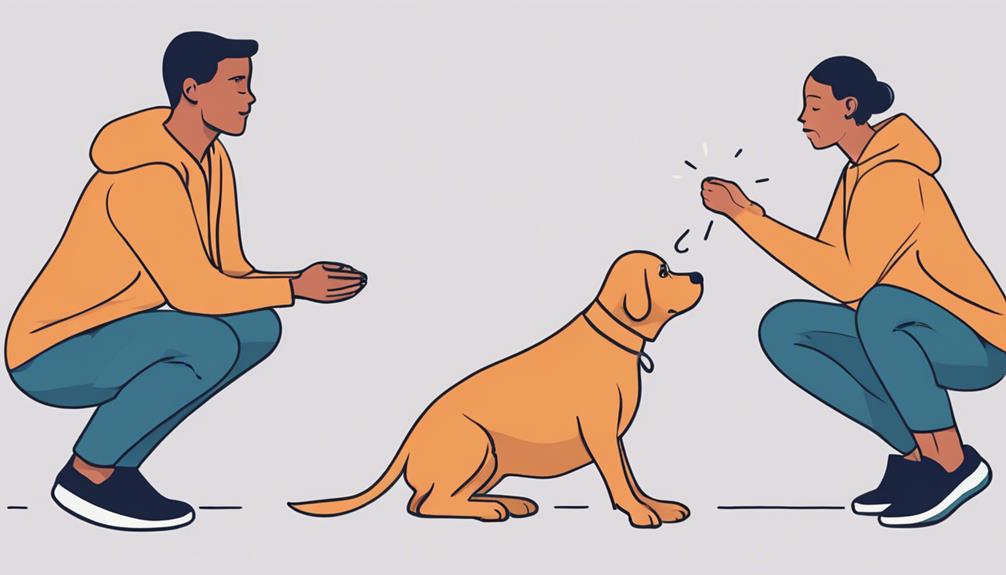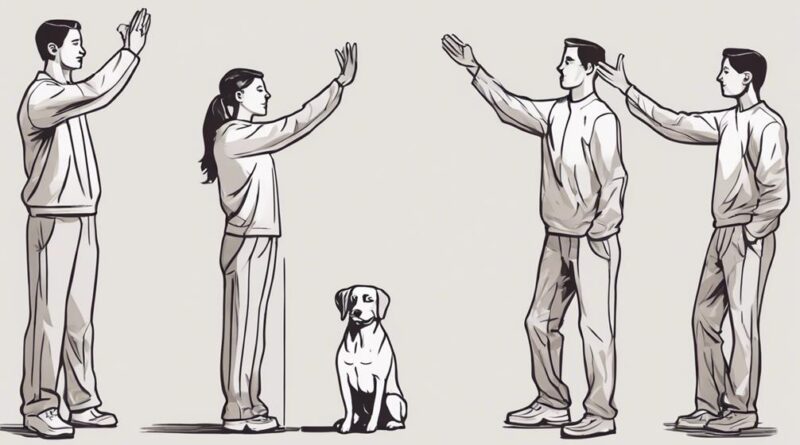3 Best Tactics for Enhanced Canine Communication Training
When it comes to canine communication training, you might find yourself torn between traditional methods and newer, more effective approaches. But what if you could blend the best of both worlds to create a harmonious training experience for your furry companion?
By honing in on understanding body language, utilizing vocal cues effectively, and implementing positive reinforcement techniques, you can pave the way for enhanced communication with your canine friend. But there's a crucial fourth tactic that ties it all together…
Understanding Canine Body Language
To understand canine body language effectively, observe their posture and tail movements closely. Canine stress signals can often be seen through various body postures such as lowered head, tucked tail, or ears pulled back. When a dog feels anxious or uncomfortable, they may exhibit behaviors like yawning, lip licking, or avoiding eye contact. These subtle cues can help you recognize when your furry friend is feeling stressed and needs reassurance.
Tail wagging meanings are essential to decipher as well. While many people associate tail wagging with happiness, it can actually indicate different emotions depending on the context. A fast wagging tail held high usually signifies excitement or a positive response. On the other hand, a slow wagging tail with a lowered position could indicate insecurity or caution. By paying attention to these tail movements along with other body language cues, you can better understand and communicate with your canine companion.
Importance of Vocal Cues
Understanding your dog's vocal cues is crucial for effective communication and bonding with your furry companion. Dogs communicate not only through barks, whines, and growls but also through the tone and pitch of these vocalizations. Here's why paying attention to your dog's vocal cues is essential:
- Vocal tone: The tone in which your dog barks or whines can convey a lot about their emotional state. A high-pitched bark may indicate excitement or playfulness, while a low growl could signal discomfort or aggression.
- Nonverbal cues: Vocalizations are often accompanied by nonverbal cues such as body language and facial expressions. By combining vocal and nonverbal cues, dogs can communicate complex messages to their owners.
- Bonding: By understanding and responding appropriately to your dog's vocal cues, you can strengthen the bond between you and your pet. This mutual understanding fosters trust and enhances the overall relationship.
- Training: Recognizing your dog's vocal cues is also crucial during training sessions. By acknowledging when they're anxious, happy, or in need of a break, you can tailor your training approach for better results.
Implementing Positive Reinforcement
How can you effectively incorporate positive reinforcement in your canine communication training?
Positive reinforcement is a powerful tool in shaping your dog's behavior. Consistency in training is key to successfully utilizing this method. When your dog displays a desired behavior, such as sitting when asked, promptly reward them with a treat or praise. This positive association encourages your dog to repeat the behavior in the future.
It's crucial to provide the reinforcement immediately after the desired behavior occurs so that your dog clearly understands what they're being rewarded for.
Utilizing Clicker Training Techniques
When incorporating clicker training techniques into your canine communication training, remember to consistently mark desired behaviors with a distinct sound to signal to your dog that a reward is coming. Clicker timing is crucial in clicker training as it helps your dog associate the click with the precise moment they exhibit the desired behavior. This clear signal aids in reinforcing the behavior effectively.
Here are some key points to keep in mind:
- Be Consistent: Ensure that every time your dog performs the desired behavior, you click promptly to maintain clarity in communication.
- Timing is Key: Click immediately after your dog displays the desired behavior to reinforce the connection between the action and the reward.
- Avoid Clicking Unintentionally: Be mindful of accidental clicks, as they can confuse your dog and weaken the training process.
- Consistent Reinforcement: Pair the click with a reward consistently to strengthen the association between the clicker sound and the positive outcome.
Developing Clear Communication Signals
To establish clear communication signals with your dog, focus on using consistent body language cues. Nonverbal cues play a crucial role in canine communication, as dogs rely heavily on visual signals to understand and respond to commands. When engaging in obedience training, it's essential to maintain a consistent posture, facial expressions, and hand gestures to convey your messages effectively. Dogs are observant creatures that can quickly pick up on subtle changes in your body language, so being mindful of your movements is key to successful communication.
During obedience training sessions, pay close attention to how your dog responds to different nonverbal cues. Adjust your signals as needed to ensure that your dog understands what you're asking for. Remember to use positive reinforcement, such as treats or praise, when your dog follows a command correctly based on your cues. By incorporating clear and consistent nonverbal cues into your training routine, you can strengthen the bond with your furry companion and improve overall communication.
Incorporating Interactive Play Sessions
Establishing a strong bond with your dog involves incorporating interactive play sessions into your routine. Playtime bonding is crucial for strengthening your relationship and enhancing communication with your furry friend.
Here are some engagement strategies to make the most out of your interactive play sessions:
- Rotate Different Interactive Games: Keep things exciting by switching up the games you play with your dog. This variety won't only prevent boredom but also help in building a stronger bond through shared experiences.
- Use Toys to Stimulate Engagement: Toys can be powerful tools for fostering engagement during playtime. Incorporate toys that encourage interaction and keep your dog mentally stimulated.
- Set Aside Dedicated Playtime: Make sure to allocate specific time for interactive play sessions each day. This consistency will create a routine that your dog can look forward to and strengthen your bond over time.
- Celebrate Small Victories: Whether it's learning a new trick or successfully completing a game, celebrate these achievements with your dog. Positive reinforcement during playtime can deepen your relationship and improve communication.
Building Trust Through Training Exercises

Engaging in consistent training exercises with your canine companion is a key component in fostering trust and strengthening your bond. Through structured training sessions, you establish a foundation built on communication and understanding. Trust building is a gradual process that requires patience and dedication. By incorporating various training exercises into your routine, you not only enhance your dog's skills but also deepen the connection between you.
Training exercises serve as opportunities for you to establish clear boundaries and expectations, which in turn help your dog feel secure and confident in their actions. Consistency in your approach to training is crucial for building trust with your canine companion. When your dog sees that you're reliable and consistent in your interactions, they learn to trust your guidance and leadership.
Consistency in Training Practices
Consistent training practices are the cornerstone of building trust and reinforcing your bond with your canine companion. When it comes to enhancing communication with your furry friend, consistency is key in ensuring they understand what's expected of them.
Here are some essential tips to help you maintain consistency in your training efforts:
- Consistent reinforcement: Make sure to reward good behavior every time it occurs. Whether it's a treat, verbal praise, or a favorite toy, consistent positive reinforcement helps your dog associate the desired behavior with a pleasant outcome.
- Clear expectations: Clearly communicate what you expect from your dog during training sessions. Use simple cues and commands to avoid confusion and provide a clear understanding of what you want them to do.
- Regular practice: Engage in training sessions regularly to help reinforce learning and maintain consistency in your communication with your canine companion.
- Patience and persistence: Remember that training takes time, so be patient and persistent. Consistency in your approach will yield positive results and strengthen your bond with your dog.
Frequently Asked Questions
Can Certain Breeds of Dogs Have Different Body Language Cues That Need to Be Considered During Training?
When training dogs, it's important to recognize that different breeds may exhibit unique body language cues. These breed differences can impact communication during training.
Understanding these variations can help address specific training challenges that may arise. By being attentive to the way different breeds express themselves through body language, you can tailor your training methods to effectively communicate and connect with your canine companion.
How Can I Effectively Transition From Using Vocal Cues to Incorporating Clicker Training Techniques?
When you're ready to shift from vocal cues to clicker training, start by introducing the clicker during your regular training sessions.
Be patient and consistent with your timing, using the clicker as a marker for desired behaviors. Follow up each click with a reward to reinforce the positive behavior.
With practice and reinforcement, your dog will quickly associate the clicker sound with a job well done.
Are There Specific Types of Treats or Rewards That Work Best for Positive Reinforcement Training?
When it comes to training rewards, different types of treats can work best for positive reinforcement. Experiment with various options to see what your canine prefers.
Some dogs might go crazy for small bits of cooked chicken or freeze-dried liver, while others may adore commercial dog treats. The key is to find what motivates your pup the most and use those treats consistently to ensure the effectiveness of your reward system.
How Can I Prevent My Dog From Becoming Overstimulated During Interactive Play Sessions?
To prevent your dog from becoming overstimulated during interactive play sessions, set clear play boundaries. Manage overexcitement by taking breaks when needed. Control engagement levels by regulating the intensity of the play.
What Should I Do if My Dog Seems to Be Struggling With Understanding My Communication Signals During Training?
If your dog seems confused during training, pay attention to your body language. Make sure your signals are clear and consistent.
Minimize distractions in the environment to help your dog focus better. If your dog still seems unsure, take a step back and break down the training into smaller, easier-to-understand steps.
Conclusion
In conclusion, by understanding canine body language, using vocal cues effectively, and implementing positive reinforcement techniques, you can enhance your communication with your furry friend.
Consistency and clear signals are key in building trust and strengthening your bond through training exercises.
Remember to incorporate interactive play sessions and utilize clicker training methods for optimal results.
With patience and dedication, you can improve your communication skills and create a harmonious relationship with your canine companion.
